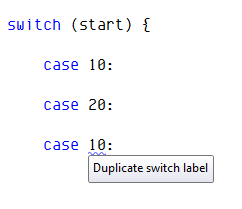ReSharper 6 Enhances the JavaScript Experience
Previous posts introducing ReSharper 6:
- ReSharper 6 EAP is Open; Details on JavaScript Support
- CSS Support in ReSharper 6
- ReSharper 6 Bundles Decompiler, Free Standalone Tool to Follow
- ReSharper 6 Enhances Suggestions with Explanations
- ReSharper 6 Introduces support for JavaScript Unit Testing with QUnit
- ReSharper 6 Enhances Razor Support
We already mentioned some of the benefits that ReSharper brings to the table when it comes to JavaScript development previously. In this post we are going to have a more in-depth look at some of the features.
Pimping jQuery
In addition to support for JavaScript, ReSharper 6 also provides certain functionality specific to jQuery.
Code Completion for Selectors
When working with jQuery selectors we often need to lookup certain DOM elements or CSS classes in order to operate with them. This can result in a back-and-forth between the code we are working on and looking up of a specific element. ReSharper 6 facilitates these cumbersome operations by providing code completion for selectors:

This completion is invoked by typing # between the quotes, where as if we were to type ., we’d get:

This completion is available anywhere a selector is required. Of course if we merely want to select a specific type of element, we also have completion:

Extending jQuery Extensions
One of the benefits of jQuery is the ease by which we can extend it to add our own functions and methods. ReSharper enhances this experience by providing completion also for custom extensions. For instance, if we were to write a new extension:

We now have myFoo available as a method of jQuery:

Much in the same way, if we want to extend an object:

we have:

Importing File References
Out of the box, Visual Studio requires a special comment to be added to script files to provide support for IntelliSense:

With ReSharper this is not required. If however, it is included, ReSharper will then limit the scope of Intellisense to the reference added. This reference can be provided by directly typing it in, in which case ReSharper offer completion:

as well as providing quick-fixes when errors are detected in paths:

Creating from Usage
Similar to C# and VB.NET, we can now also create JavaScript code based on usage. For instance, let’s say we write some code that calls a specific function named getInterval that does not yet exist. ReSharper prompts us to create a local function:

generating the code for us, providing us the same ability we have in C# to iterate through parameter names etc. The same applies to variables:

as it does to creating parameters and properties; once again, making the whole development experience a bit smoother.
Last but not least, ReSharper also provides the ability to create jQuery extension methods from usage:

Refactoring
Certain refactoring operations are now available in JavaScript. Firstly, in combination with Create from Usage, we can now easily add an extra parameter to a function call and have ReSharper offer to create it for us:

Introduce Variable is another refactoring option available:

And last but not least, Rename:

ReSharper is smart enough to handle the scope of the renaming outside of the current local scope, prompting you always with the option to fine-tune certain renaming’s.
Code Cleanup and Rearranging
In a previous blog post we mentioned briefly the code formatting options for JavaScript. These have now been extended and better organized. We can fine tune Lines Breaks, Braces Layout as well as Space via ReSharper | Options | JavaScript | Formatting Style. Below are the options for the newly added Spaces:

Running code-cleanup on JavaScript files is of course now also possible:

Also, out of the box, we provide certain filters, both in clean-up and analysis, such as those with min.* extensions. These can be changed in the options dialog, albeit it’s not highly recommended.

Rearranging Code
You can now rearrange code which includes moving parameters around, moving members up/down as well as arguments and object literals and arrays. All this is done using the same key combination as used in C# and VB.NET (Ctrl+Alt+Shift + Cursor Keys).
Code Inspections
JavaScript is a dynamic language. It has great advantages but can prove to be not the easiest language to work with, specially for novices. We’ve tried to ease some of that pain by providing code inspections, where possible. Among the many code inspections that currently are available are:
- Syntax errors:

- Unused symbols:

- Dead code:

- Duplicate switch statements:

- Misuse of “this”:

- Accessing undefined global symbols:

And this is just a few of the over 25 inspections that ReSharper supports along with their corresponding quick fixes. We believe that this will help remove some of the issues encountered at runtime, specially by newcomers.
Miscellaneous
Some of the other features provided for JavaScript are:
- Configurable Naming Conventions: Much like C# and VB.NET you can define your own naming conventions.

- Context Actions Settings: You can fine-tune which of context actions you want enabled.

- Live Templates: Some predefined templates plus the ability to create custom live templates for JavaScript.
- Navigation and Find Usages: Context-sensitive and context-insensitive (“Go to”) navigation support as well as Find Usages for JavaScript members. This was mostly covered in a previous post.
- Unit Testing: Support for JavaScript unit testing with QUnit covered in a dedicated post.
- Coding Assistance: Syntax highlighting, highlighting for matching delimiters, ability to comment and uncomment blocks of code etc. See previous post for some screenshots.
All in all, we hope that some of these features allow JavaScript to become a language to that easier to learn, use and enjoyable.
ReSharper 6 is currently in EAP. Download it today and start playing with it. We’d love to hear your feedback..
Subscribe to a monthly digest curated from the .NET Tools blog:







